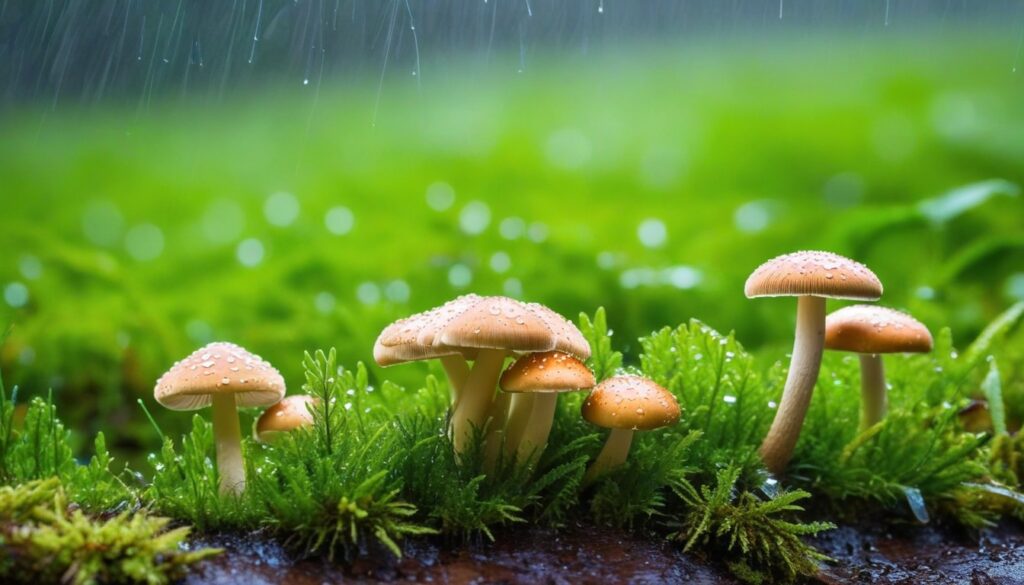If you’ve ever taken a walk in the woods after rainfall, you may have noticed small clusters of mushrooms popping up seemingly out of nowhere. But have you ever wondered how long it takes for mushrooms to grow after rain?
In this comprehensive guide, we’ll explore the world of mushroom growth and delve into the precise timing of their emergence after rainfall. From understanding the basic process of mushroom development to the factors that can affect their growth, we’ll provide insights into this fascinating topic.
Key Takeaways:
- The timing of mushroom growth after rain is affected by various environmental factors.
- Rainfall is a crucial trigger for mushroom growth, providing the necessary moisture for their development.
- Temperature, soil composition, and habitat conditions can also affect the growth timeframe of mushrooms.
- Different types of mushrooms have varying growth patterns and timelines.
- Observing mushroom growth in the wild requires proper identification and caution due to the potential risks associated with consuming wild mushrooms.
Understanding Mushroom Growth
Before we dive into the timing of mushroom growth, let’s explore the process of how mushrooms develop and thrive.
Mushrooms are part of the fungi kingdom and start their life as spores. These spores can come from the air, soil, or even other mushrooms.
Once the spores find a suitable substrate, they germinate and form a web-like network of cells called mycelium. The mycelium then grows and consumes organic matter, breaking it down into nutrients for the mushroom to use.
When the mycelium reaches a certain maturity, it forms a mushroom fruiting body. This transition is triggered by environmental factors such as temperature, humidity, and the availability of nutrients.
Once the fruiting body has formed, it continues to grow and develop until it reaches maturity, at which point it releases spores that continue the cycle of growth and reproduction.
Factors such as temperature, humidity, and substrate composition can influence the growth and development of mushrooms. Understanding these factors and their influence on mushroom growth is essential in predicting their emergence after rain.
The Role of Rainfall in Mushroom Growth
For mushrooms to grow, they need moisture, and rainfall is one of the primary sources of this essential ingredient. Rainfall provides mushrooms with the hydration they require for growth, and it also plays a crucial role in the development of the fruiting body, which is the visible, above-ground part of the mushroom.
When rainwater permeates the soil, it causes an increase in soil moisture, which is essential for the growth of mushrooms. The additional moisture triggers the expansion of the mass of fungal threads called mycelium. Mycelium growth is an important stage in the life cycle of mushrooms, and it happens unseen underground.
As the mycelium absorbs water, it begins to produce the fruiting body, which is the part of the mushroom we typically see. The fruiting body is the reproductive structure of the mushroom, and it is where spores are produced and released into the air.
It’s important to note that while rainfall is crucial for mushroom growth, it’s not the only factor that contributes to it. Temperature, humidity, and soil composition also play a significant role in the growth process. In the next section, we’ll explore the influence of temperature on mushroom growth after rainfall.
The Influence of Temperature on Mushroom Growth
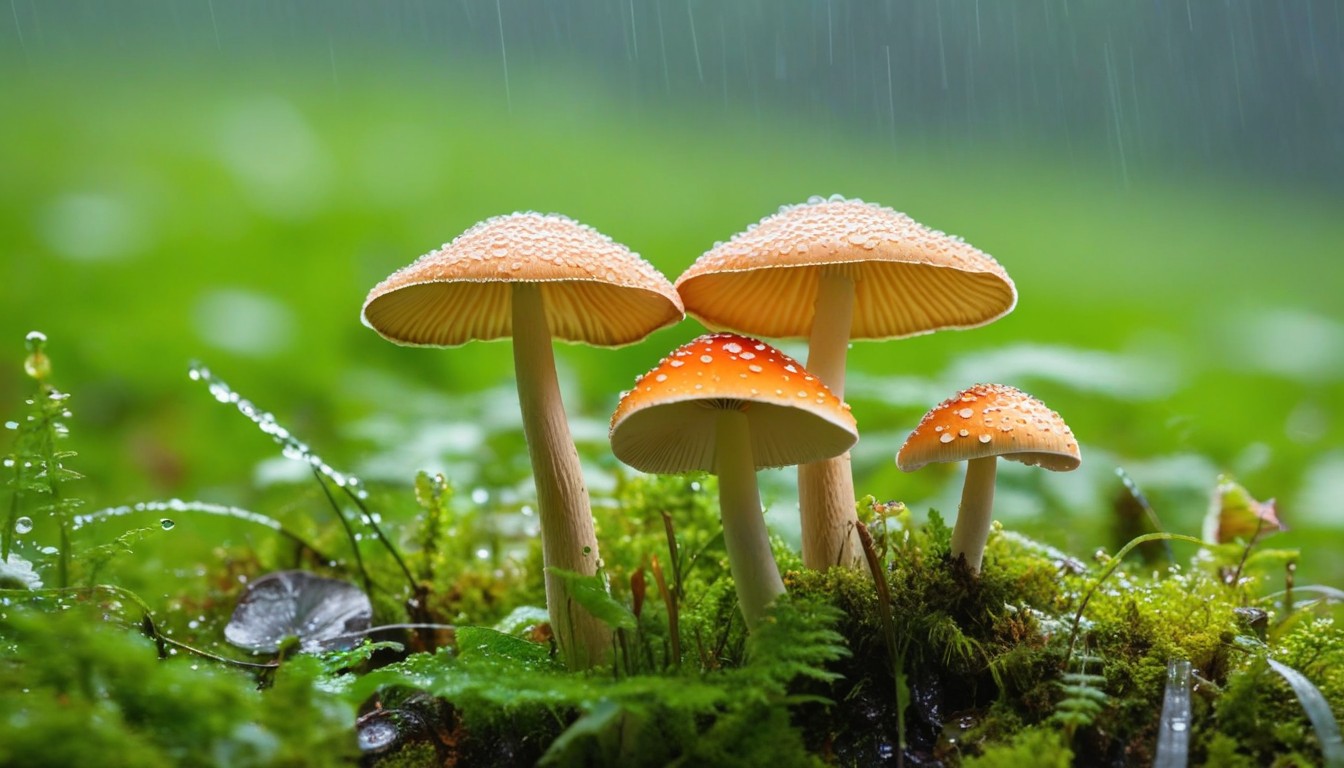
Temperature plays a critical role in the growth of mushrooms. It affects the timing of their emergence after rainfall and can impact the yield and quality of the mushrooms.
The ideal temperature range for most mushroom species is between 55°F and 65°F. However, some species have a wider range, while others prefer warmer or cooler temperatures.
When the temperature is too low, the growth of mushrooms slows down, and they may fail to develop entirely. Similarly, when the temperature is too high, mushrooms may grow too quickly, resulting in soft, spongy, or deformed caps that do not produce spores.
Temperature also affects the duration of the mushroom growth cycle. The warmer the temperature, the shorter the growth cycle, and vice versa. For example, the growth cycle of the common button mushroom (Agaricus bisporus) is around six weeks at 55°F but only four weeks at 75°F.
The Impact of Temperature on Mushroom Species
Different mushroom species have unique temperature requirements for optimal growth. For example, oyster mushrooms (Pleurotus ostreatus) prefer a temperature range of 60°F to 75°F, while shiitake mushrooms (Lentinula edodes) thrive in a range between 50°F and 75°F.
Some species can tolerate extreme temperatures, such as the wood ear mushroom (Auricularia auricula-judae), which can survive freezing temperatures. Others, such as the lion’s mane mushroom (Hericium erinaceus), require more controlled temperature and humidity conditions to grow successfully.
Temperature Control in Mushroom Cultivation
In controlled mushroom cultivation, temperature is a key factor that growers can regulate to achieve optimal growth conditions. This is especially important for species that have specific temperature requirements or for growers who want to accelerate or delay the growth cycle.
Indoor cultivation methods, such as using grow tents or greenhouses, allow growers to control the temperature and humidity levels to create an ideal environment for mushroom growth. Mushroom farming is another method that uses climate-controlled facilities to ensure optimal conditions for growing mushrooms.
“Maintaining consistent temperature and humidity levels is essential in mushroom cultivation to ensure a high yield and quality of the final product.”
In conclusion, temperature is a vital factor that affects mushroom growth and plays a significant role in determining their emergence after rainfall. Different mushroom species have unique temperature requirements, and controlling the temperature in mushroom cultivation can lead to higher yields and better-quality mushrooms.
Types of Mushrooms and Their Growth Patterns
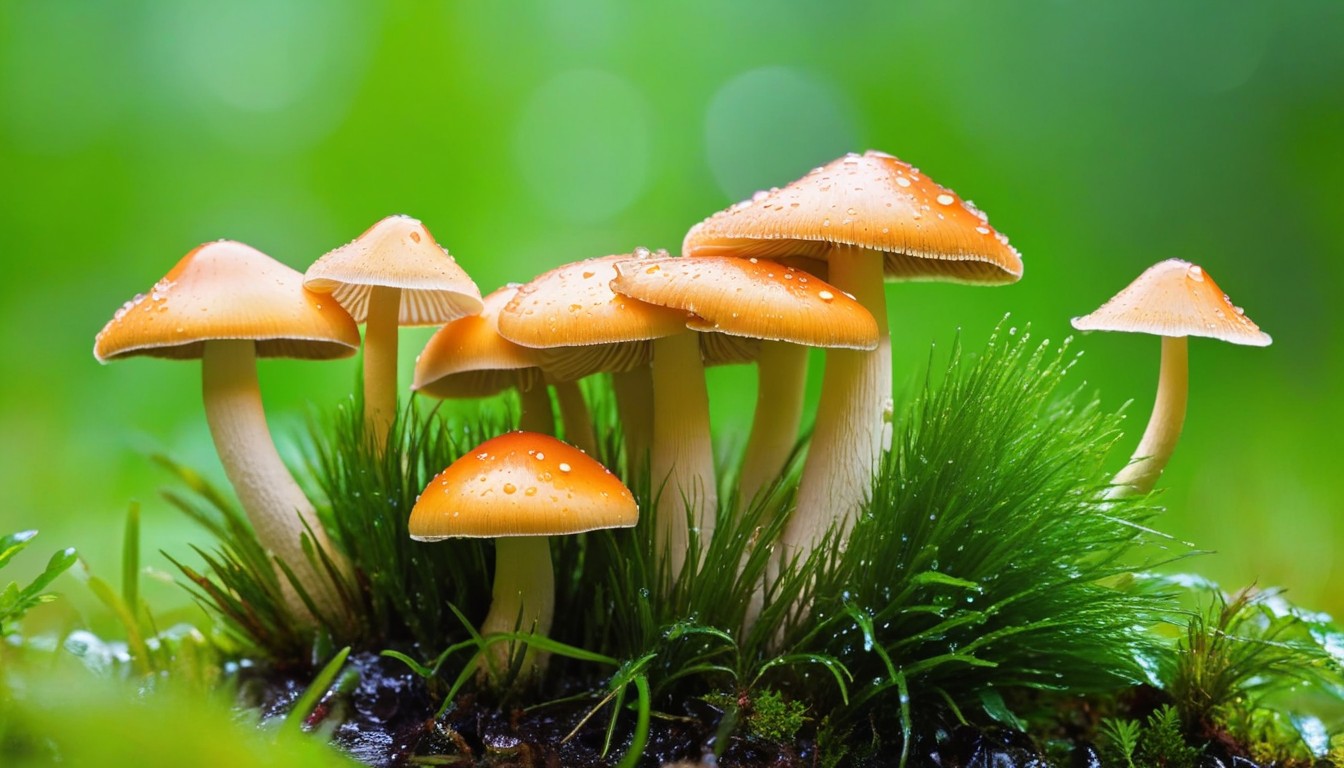
There are numerous types of mushrooms, each with their own unique growth patterns and timelines. Understanding these differences can help you identify different species and anticipate when they might appear after rainfall. Let’s take a closer look at some common types of mushrooms and their growth patterns.
Button Mushrooms
Button mushrooms are a popular variety found in supermarkets. They typically grow in fields and meadows and have a short growth cycle of just a few weeks. After a heavy rain, button mushrooms can appear within a few days and continue to grow rapidly for up to a week.
Chanterelle Mushrooms
Chanterelle mushrooms are known for their vibrant golden color and fragrant aroma. They grow in mossy areas and forests and are a bit trickier to spot than button mushrooms. Chanterelles usually appear after a few days of consistent rain and can continue to grow for several weeks.
Morel Mushrooms
Morel mushrooms are a delicacy prized for their unique shape and flavor. They grow in wooded areas and are typically found in the spring. Morels require sustained periods of rain to trigger their growth, sometimes taking up to a week or more after rainfall to sprout. Once they do, however, they can continue to grow for several weeks.
Shiitake Mushrooms
Shiitake mushrooms are an Asian variety commonly used in cooking. They grow on logs or dead trees and require consistent moisture to develop. Shiitakes can take several weeks to appear after rainfall, but once they do, they can continue to fruit for several months.
Oyster Mushrooms
Oyster mushrooms grow in clusters on logs and dead trees. They are popular in Asian cuisine and have a delicate taste and texture. Oyster mushrooms usually appear a few days after consistent rainfall and can continue to grow for several weeks.
By understanding the growth patterns of different types of mushrooms, you can increase your chances of spotting them after rainfall and broaden your knowledge of the diverse world of fungi.
Factors Affecting the Timeframe for Mushroom Growth
While rain is a crucial trigger for mushroom growth, various other factors also play a role in determining the timeline for their emergence. Understanding these elements can help you anticipate when and where mushrooms are most likely to grow after rainfall. Some of the most significant factors affecting mushroom growth include:
- Soil composition: The composition of the soil in which mushrooms grow can impact their emergence after rainfall. Mushrooms prefer moist, nutrient-rich soil, and the presence of organic matter like decaying leaves or wood can encourage growth.
- Humidity: High levels of humidity are crucial for mushroom growth, as they require a moist environment to develop. Dry conditions can delay or prevent the emergence of mushrooms, even after rainfall.
- Temperature: Temperature is another essential factor in determining the timing of mushroom growth. Different species have varying ideal temperature ranges, and extreme heat or cold can interfere with their growth. For instance, most mushrooms prefer temperatures between 60-70°F, while oyster mushrooms thrive in slightly cooler conditions of 55-65°F.
- Light: While mushrooms don’t require light to grow, it can be a useful indicator for their emergence. Some species, such as the yellow-orange chanterelle, tend to grow in areas with ample sunlight, while others prefer more shaded environments.
- Disturbances: Finally, any disturbance to the mushroom’s environment can affect its growth timeline. For example, if the soil is compacted or the habitat is disrupted by construction or land development, it can delay or prevent the emergence of mushrooms.
Observing Mushroom Growth in the Wild
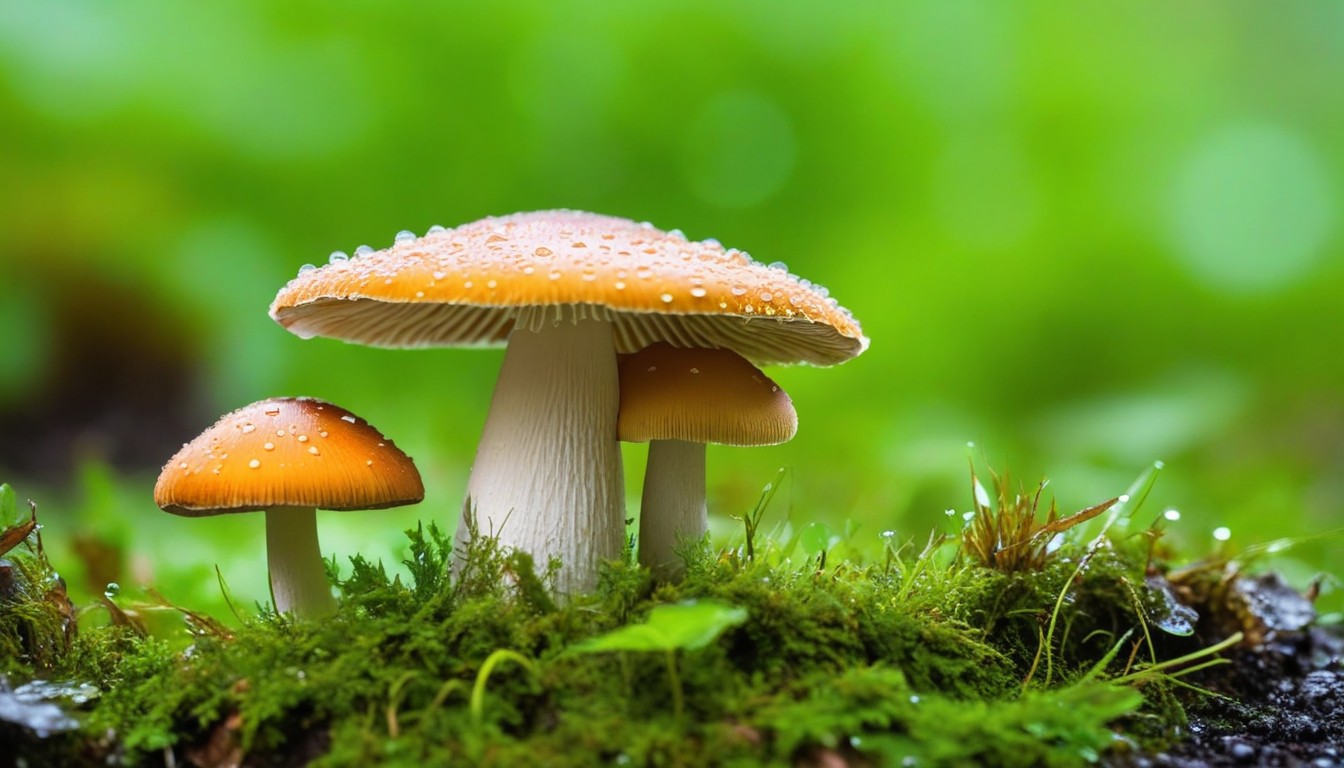
If you’re a nature enthusiast, observing mushroom growth after rain can be a fascinating experience. Mushrooms can grow in a variety of habitats, including forests, fields, and even in your own backyard. However, it’s essential to take proper precautions when handling them, as some wild mushrooms can be toxic or even deadly.
Tips for Observing Mushrooms
Here are a few tips to keep in mind when observing mushrooms in the wild:
- Look for mushrooms in damp areas with plenty of decaying matter, such as fallen leaves or rotting logs.
- Take note of the time of year, as some mushroom species have specific growth cycles.
- Pay attention to the shape, color, and texture of the mushroom cap and stem to help with identification.
- Use a field guide or consult with an expert if you’re unsure about a mushroom’s identity.
Mushroom Identification
Proper identification is critical when observing mushrooms in the wild. Some mushrooms are safe to eat, while others can cause severe illness or even death. If you plan on consuming wild mushrooms, it’s best to consult with an experienced forager or mycologist to help with identification.
“All mushrooms are edible, but some only once.” – Croatian proverbs
It’s also essential to understand the risks associated with consuming wild mushrooms. Symptoms of mushroom poisoning can include nausea, vomiting, diarrhea, and even organ failure. If you experience any of these symptoms after consuming wild mushrooms, seek medical attention immediately.
Appreciating Mushroom Growth
Observing mushroom growth can be a fun and educational experience, even if you’re not planning to consume them. Taking the time to appreciate the intricate details of the mushroom’s structure and growth patterns can deepen your understanding of the natural world around us. Just remember to always take proper precautions and treat wild mushrooms with the respect they deserve.
The Aftermath of Rain: Mushroom Spore Distribution
Rain not only triggers the growth of mushrooms but also plays a crucial role in spreading their spores. When raindrops hit the mature mushroom cap, the force creates a miniature explosion, shooting the spores into the air. The high humidity in the aftermath of rain allows the airborne spores to remain suspended, increasing the likelihood of their dispersal and colonization.
The spores are microscopic, and a single mushroom can produce millions of them. The spores are carried by wind or other factors, such as insects or animals, and deposited when the conditions are favorable for germination. These conditions include moisture, warmth, and a suitable substrate.
“Raindrops hitting mushroom caps cause a miniature explosion, shooting the spores into the air.”
The distribution of mushroom spores is vital to the growth and survival of the species. It allows for genetic diversity, genetic mixing, and colonization of new habitats. However, spore dispersal isn’t always a positive thing. In some cases, mushroom spores can cause allergies or respiratory problems in humans or animals. Also, some spores can contaminate crops or other plant life, causing economic and ecological damage.
The spores of some mushroom species are also prized for their culinary and medicinal uses. For instance, the spores of the shiitake mushroom are used to make a fragrant broth, while the reishi mushroom spores are believed to have immune-boosting properties.
|
Mushroom Species |
Spore Characteristics |
Uses |
|---|---|---|
|
Shiitake |
White to light brown, ellipsoidal |
Culinary |
|
Portobello |
Dark brown, round to oval |
Culinary |
|
Reishi |
Red-brown, kidney-shaped |
Medicinal |
|
Golden Oyster |
Yellow to golden, round |
Culinary |
Overall, understanding the role of rain in mushroom growth and spore distribution can deepen your appreciation for the fascinating world of fungi. Whether you’re interested in identifying wild mushrooms, cultivating them in your backyard, or incorporating them into your diet, paying attention to the role of rain will enhance your knowledge and enrich your experience.
The Factors that Can Delay Mushroom Growth After Rainfall
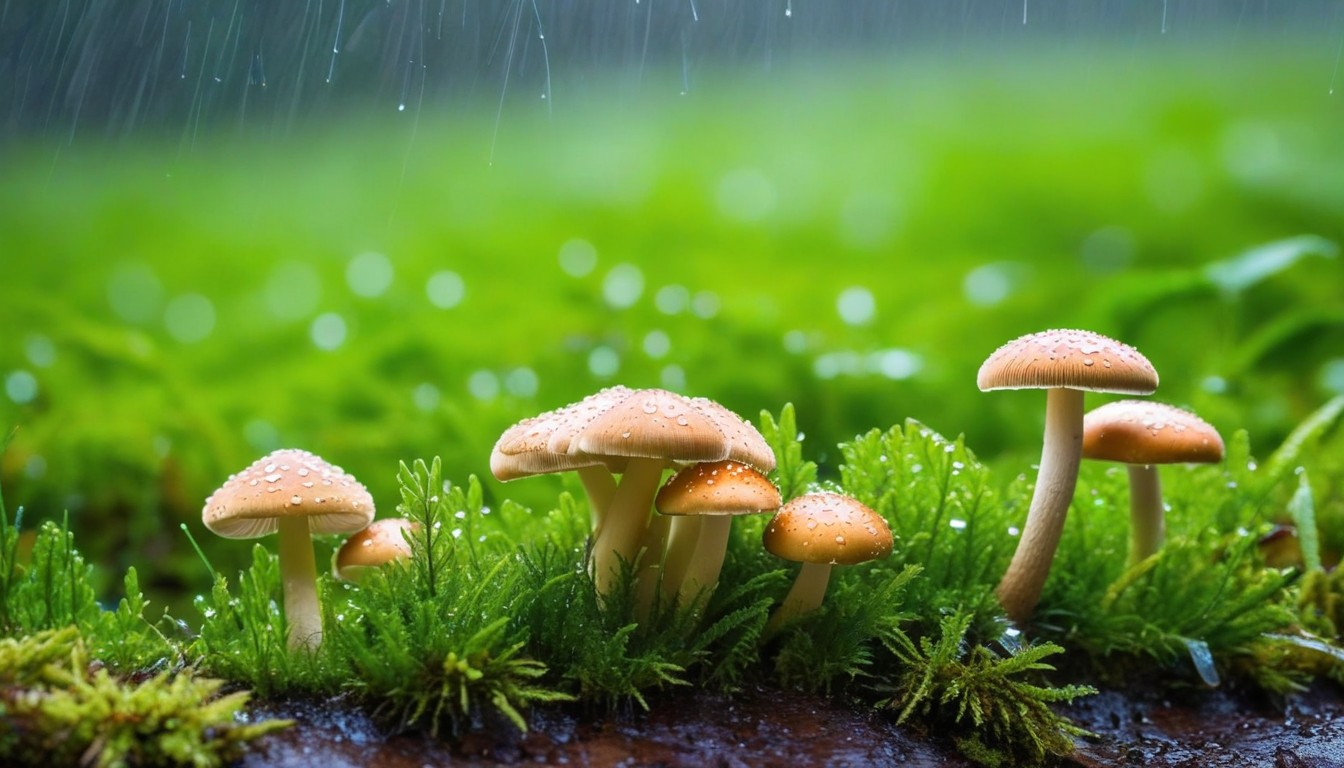
While mushrooms typically sprout after rainfall, several factors can delay their growth. It’s important to understand these factors to manage your expectations when searching for mushrooms in the wild.
Extended Drought Periods
Extended periods of drought can significantly impact mushroom growth. When there isn’t enough moisture in the soil, mushrooms won’t be able to develop properly. So, even after a rainfall, if the soil has been experiencing a prolonged lack of moisture, it may take longer for mushrooms to grow.
Extreme Temperatures
Both too much heat and too much cold can disrupt mushroom growth. Generally, temperatures between 50 and 70 degrees Fahrenheit are ideal for most mushroom species. If the temperature falls outside of this range, it can either slow down mushroom growth or altogether prevent it.
Disturbances in the Mushroom’s Habitat
Any sudden changes in the mushroom’s habitat can potentially delay growth. This includes disruptions caused by construction, heavy foot traffic, or changes to the soil composition. When there’s a sudden change in the mushroom’s environment, it may need extra time to adjust before resuming its growth process.
Note: Keep in mind that mushrooms require a specific set of conditions to grow, and these conditions can vary greatly depending on the species. It’s always best to research the type of mushroom you’re looking for to understand the ideal conditions for growth.
Cultivating Mushrooms: Controlling the Growth Process
If you’re a fan of mushrooms and want to grow them yourself, you’re in luck! Cultivating mushrooms is easier than you might think, and it allows you to control the entire growth process from start to finish. Here are some tips to get you started:
Choose Your Mushroom Type
The first step in cultivating mushrooms is to choose the type of mushroom you want to grow. Different mushrooms have different growth requirements, so it’s important to select a species that’s suitable for your setup and environment. Some popular types of mushrooms for cultivation include oyster, shiitake, and button mushrooms.
Prepare Your Growing Medium
The growing medium is the material in which your mushrooms will grow. Most commonly, mushrooms are grown in a substrate made from straw, sawdust, or a mixture of the two. The substrate should be sterilized to eliminate any potential contaminants that could harm your mushrooms.
Inoculate Your Substrate
Once your substrate is ready, you’ll need to inoculate it with mushroom spores or spawn. You can purchase mushroom spawn from a reputable supplier or create your own by collecting spores from mature mushrooms. After inoculating your substrate, place it in a sealed container and allow it to colonize over a period of several weeks.
Provide Optimal Growing Conditions
Like all living things, mushrooms require specific growing conditions to thrive. The ideal temperature range for most mushrooms is between 60 and 75 degrees Fahrenheit, and they need high humidity levels to grow properly. Additionally, mushrooms require fresh air to circulate around the growing area, so ventilation is important.
Harvest Your Mushrooms
After several weeks of growth, your mushrooms should be ready for harvesting. Use a sharp knife or scissors to cut the mushrooms at the base of the stem, being careful not to damage the surrounding substrate. Once you’ve harvested your mushrooms, you can either eat them fresh or store them in the refrigerator for later use.
Cultivating mushrooms is a rewarding and exciting hobby that allows you to control the entire growth process from start to finish. With the right materials and growing conditions, you can produce a plentiful supply of delicious and nutritious mushrooms for your table.
Conclusion
By understanding the complex factors that contribute to the growth of mushrooms after rain, we can appreciate the fascinating world of fungi that surrounds us.
Takeaways
From the role of rain and temperature to the unique characteristics of different mushroom species, we’ve explored the various factors that influence the emergence of mushrooms after rainfall.
Whether you’re an avid mushroom hunter, a curious observer, or a budding mycologist, there’s always more to learn about the growth and development of these intriguing organisms.
By observing the subtle changes in mushroom habitats and staying informed about environmental conditions, you can enhance your knowledge and appreciation for the intricate processes that underlie mushroom growth.
The Future of Mushroom Research
As our understanding of fungal ecology and genetics continues to evolve, there’s a growing interest in the potential applications of mushroom cultivation and mycoremediation.
From bioremediation to food production, mushrooms offer a promising avenue for sustainable development and environmental restoration.
As our knowledge of mushroom growth and development expands, we can look forward to exciting new discoveries and innovations in the field of fungal research.
FAQ
How long after rain do mushrooms typically grow?
The timing of mushroom growth after rain can vary depending on several factors such as mushroom species, temperature, and soil conditions. Generally, mushrooms tend to emerge within a few days to a couple of weeks after rainfall.
What factors contribute to the growth of mushrooms?
The growth of mushrooms is influenced by various factors, including rainfall, temperature, humidity levels, soil composition, and the presence of decaying organic matter. These elements create the ideal conditions for mushroom development.
Are all mushrooms visible after rain?
Not all mushrooms become visible immediately after rain. Some species may take longer to establish themselves and become visible. Additionally, certain mushrooms may have growth patterns that are not directly correlated to rainfall.
Can I eat wild mushrooms that grow after rain?
It is crucial to exercise caution when consuming wild mushrooms, even if they have grown after rain. Some mushrooms can be toxic or hallucinogenic, while others may be edible and delicious. Proper identification and expert guidance are recommended before consuming wild mushrooms.
How can I identify mushrooms in the wild?
Identifying mushrooms can be challenging as there are numerous species with varying characteristics. It is advisable to study field guides or consult with experienced mycologists to learn about different mushroom species and their distinguishing features.
Can mushrooms grow indoors?
Yes, mushrooms can be cultivated indoors using specialized techniques. Indoor cultivation offers more control over the growth process, allowing for predictable timelines and consistent results. Mushroom farming is a popular method for indoor cultivation.
Can extreme temperatures delay mushroom growth?
Yes, extreme temperatures, whether hot or cold, can delay or inhibit mushroom growth. Mushrooms have specific temperature preferences for their development, and deviations from their ideal range can impact their growth timeline.
Do mushrooms release spores during or after rain?
Mushrooms release their spores during and after rain. Rainfall aids in the dispersal of mushroom spores, helping them colonize new areas and reproduce. The spores are carried by water droplets and wind to spread across the surrounding environment.
Can I control the timing of mushroom growth during cultivation?
In controlled cultivation, it is possible to manipulate the timing of mushroom growth to some extent. By adjusting factors such as temperature, humidity, substrate composition, and lighting conditions, growers can influence the growth timeline of cultivated mushrooms.
Are there any risks associated with consuming wild mushrooms?
Yes, consuming wild mushrooms without proper identification can be risky. Some wild mushrooms contain toxins that can cause severe illness or even be fatal. Unless you are confident in your identification skills, it is best to seek guidance from experts before consuming wild mushrooms.

